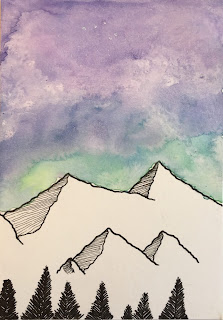I recently discovered and fell in love with the art of UK artist Jo Grundy. Her beautiful work can be found here. She paints mainly landscapes of her native England, in different seasons. Her work is so detailed and textured, and has a graphic quality. The atmosphere her work exudes is calming and dreamy, particularly her winter landscapes.
 |
| Thursday adult class collage |
 |
| Tuesday adult class collage |
Jo Grundy's winter landscape work was just it! Her overlapping rolling hills create beautiful landscape depth. Each hilltop is painted with elements (trees, houses, shrubs) which are fit to scale according to the depth of her picture plane - and these in turn are painted according to the laws of atmospheric perspective: things that are future away from the viewer are higher on the picture plane, subtler, less detailed, blurry, lighter, and warmer in color, while things closer to the viewer, or lower on the picture plane, are more detailed, crisper, a most intense color, darker and cooler in color. Observing and replicating this helps my students understand atmospheric perspective, which is an important skill in painting.
Jo's winter landscapes also use a limited palette with tints. I love the idea of limiting palettes, as it forces students to mix their own colors. Creating tints with a limited palette infinitely expands our palette while maintaining a cohesive and harmonious atmosphere of soft, cool, wintery tints and tones.
Color palette:
Blue (ultramarine and cobalt), burnt sienna and burn umber, a dark green (but you could mix your own), a touch or red and yellow and plenty of white. Students mixed blues and browns together to create grays. Blues, green and black were mixed for our dark hedges and trees. To darken any value (for things lower in the picture plane) we simply added a hint of black or burnt umber, while we added a touch more white to soften or lighten a value (for things further away on the picture plane).
White was used throughout to create soft pinks, blues, grays, and of course, the snowy white.
Brushes:
We used many different brushes. Very important was a tiny detail brush (#1 or 2) for our smallest, fine details. We used a round brush with a good tip for our larger areas. A bristle brush was used in a dry brush technique to stipple white paint over top of our elements to create snow, shadows or texture. This is a super fun technique that adds instant dimension and realistic texture to our landscape elements.
Process:
Students chose a Jo Grundy painting that they wished to reproduce. We taped the borders of our watercolor paper with artist tape or washi tape, which will give us a beautifully clean and crisp border when done. We began by lightly draw in the basic landscape shapes in pencil - so the hills and fields. No details were drawn in, as these would be painted in directly at a later stage. Larger houses were drawn in, but smaller ones were not.

These basic landscape shapes were then painted. We started from the top of our composition and moved downward. Sky first, highest hills, middle-ground hills, foreground fields, etc. We observed the values in our landscape shapes closely and tried to achieve a close value match. Important is not that our color matches the colors in the pictures exactly, but that the 'value relationship' matches. This will ensure that our atmospheric perspective is correct. In Grundy's work, each rolling hill has a slightly different value as it comes down the picture plane. This gives the illusion of depth and distance.

Once these shapes were blocked in we slowly started adding in the foundation of our details, always working from top down: hedges, trees, houses. Hedges were dry brush stippled with a flat head bristle brush in a dark color (a mix of blue, green and black or umber). Once dry, white was dry brush stippled over top for the snow. Trees were painted in a similar dark color with a detail brush, and snow was dry brush stippled over top the branches with a bristle brush. This technique was used in other areas too, wherever necessary, such as chimney smoke, a snowy rooftop, smudgy shadows, or for texture in flowers or a field. Detail brushes were used to add birds, animals, flowers and weeds.

Thinking like an artist: Some students used credit cards to scrape paint upwards to create the texture of weeds and grasses in their foreground. Some students used colored pencils to sketch in very small details, where a brush might not do the job. Colored pencil was also used by some to add texture to areas with fine detail, such as a pebbly walkway. Throughout this project my students exhibited great creativity and problem-solving in figuring out how best to recreate Grundy's work. This is one reason why I really love having students copy other artists' work: it forces you to be creative in looking for solutions and exploring possible outcomes.

This project was definitely challenging and the process was slow and deliberate. It took us two 3-hour sessions to complete. Students worked in deep concentration and were totally zen throughout. My role was to help guide them in their process, assist them with color mixing, give periodic constructive critique and support with positive words and encouragement. In the end, they came out of a near-euphoric stupor having learned so much about color mixing, the power of observation, atmospheric perspective and creating texture. They created luscious, beyond beautiful work that truly amazed. We were all elated by the experience. What a wonderful way to round out a great semester in the Art Room - and we have Jo Grundy to thank for the awesome inspiration!

















































